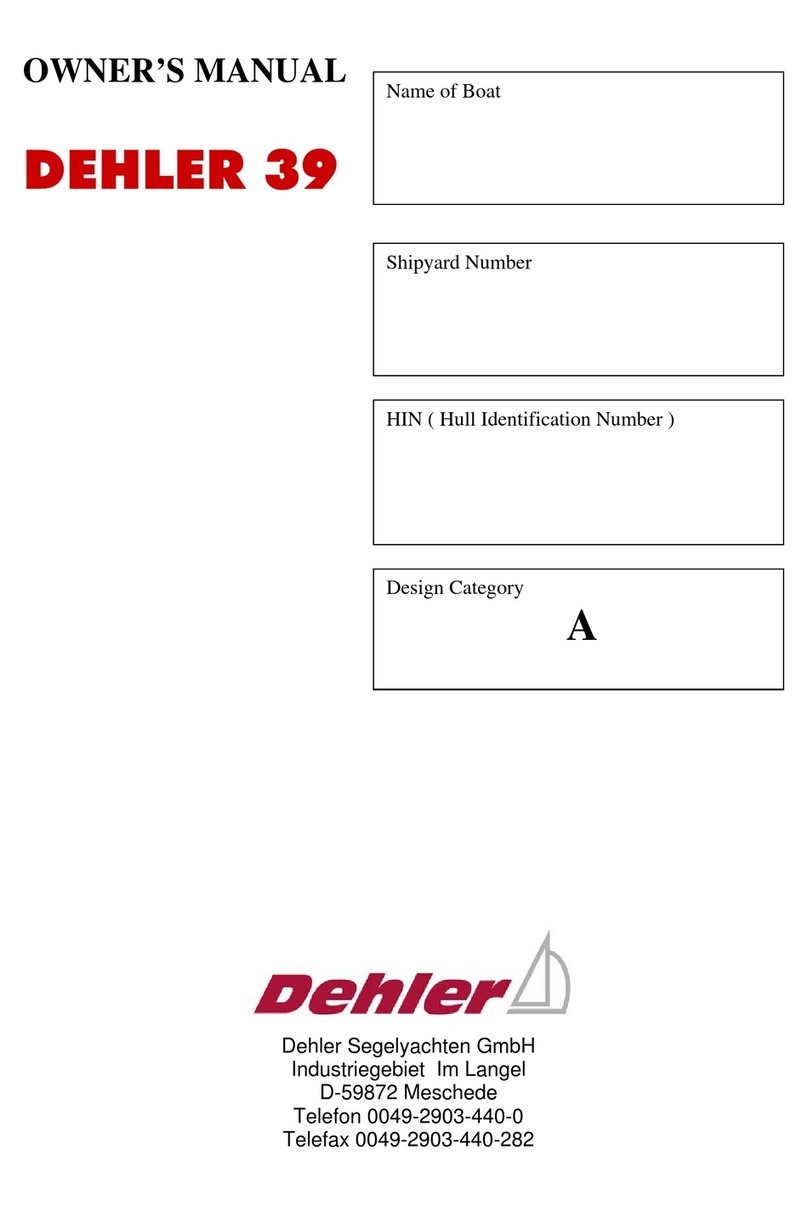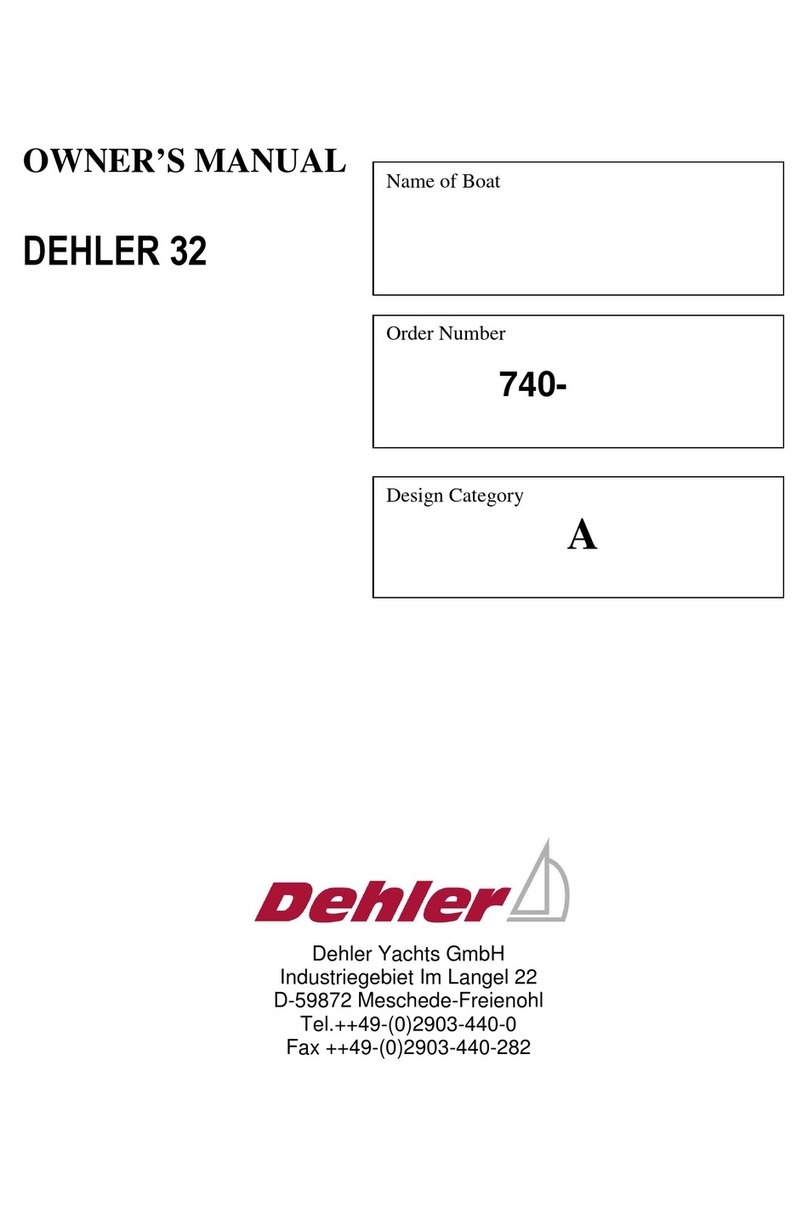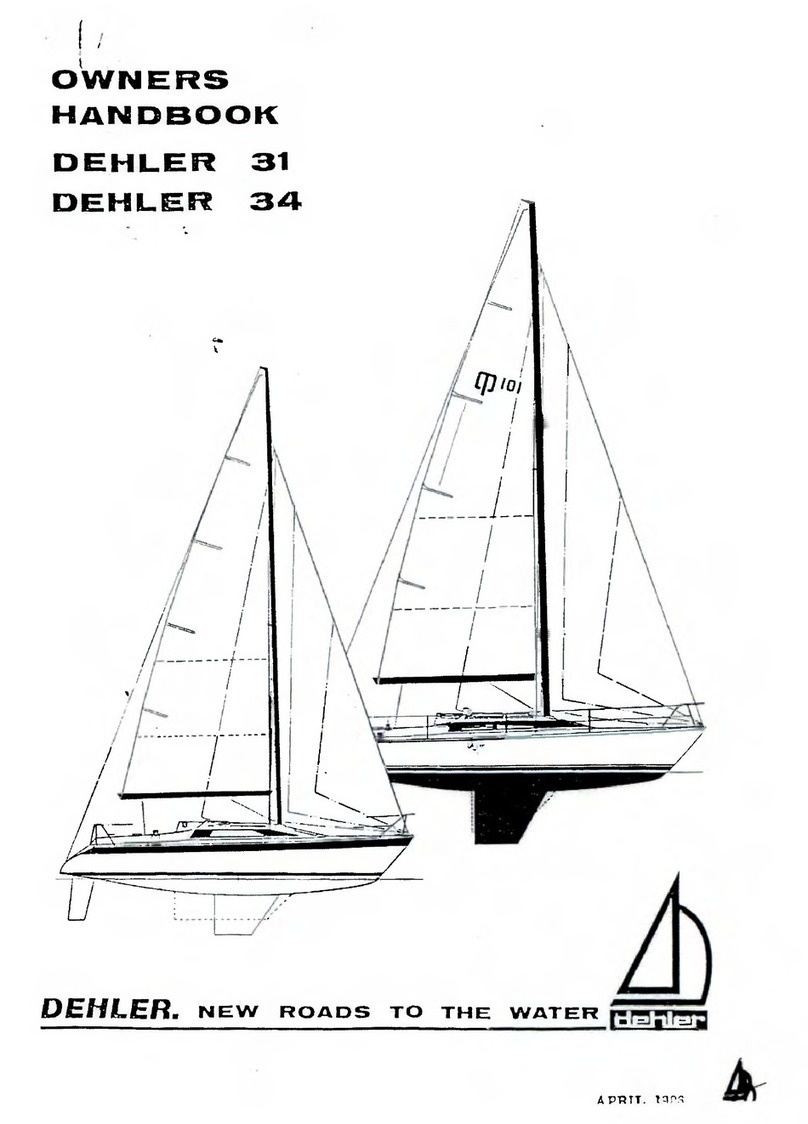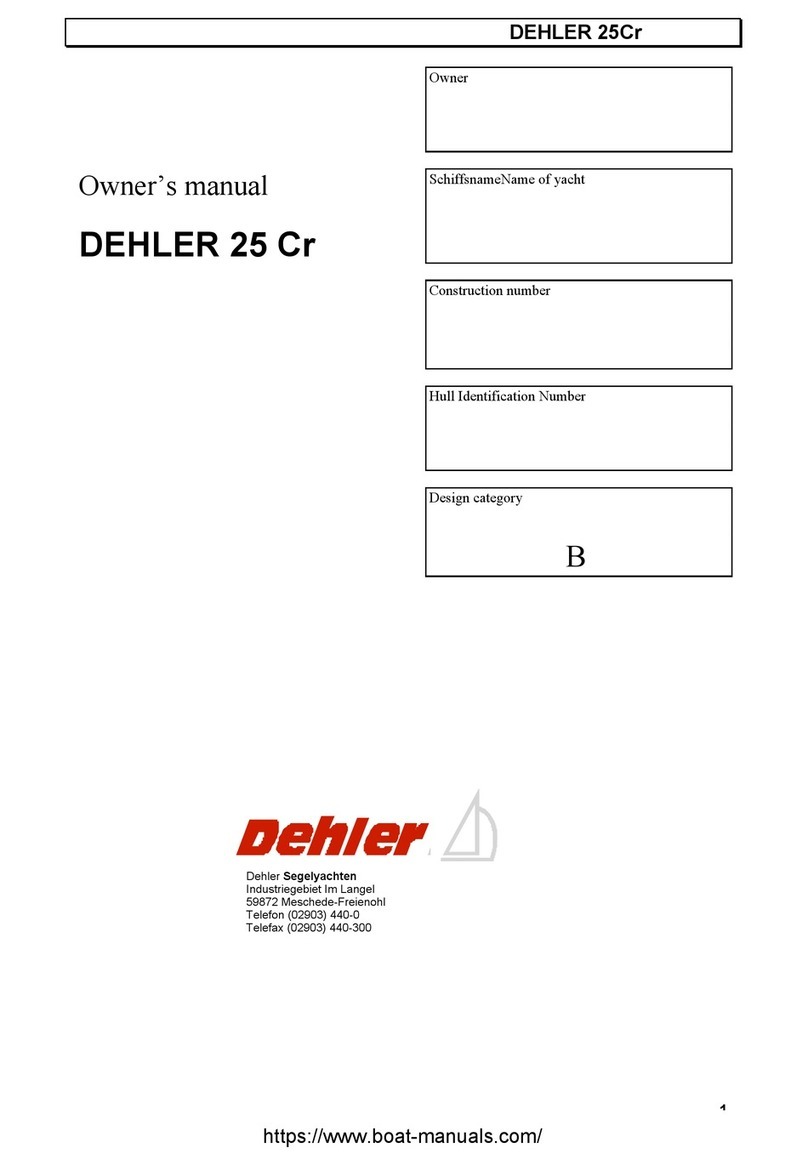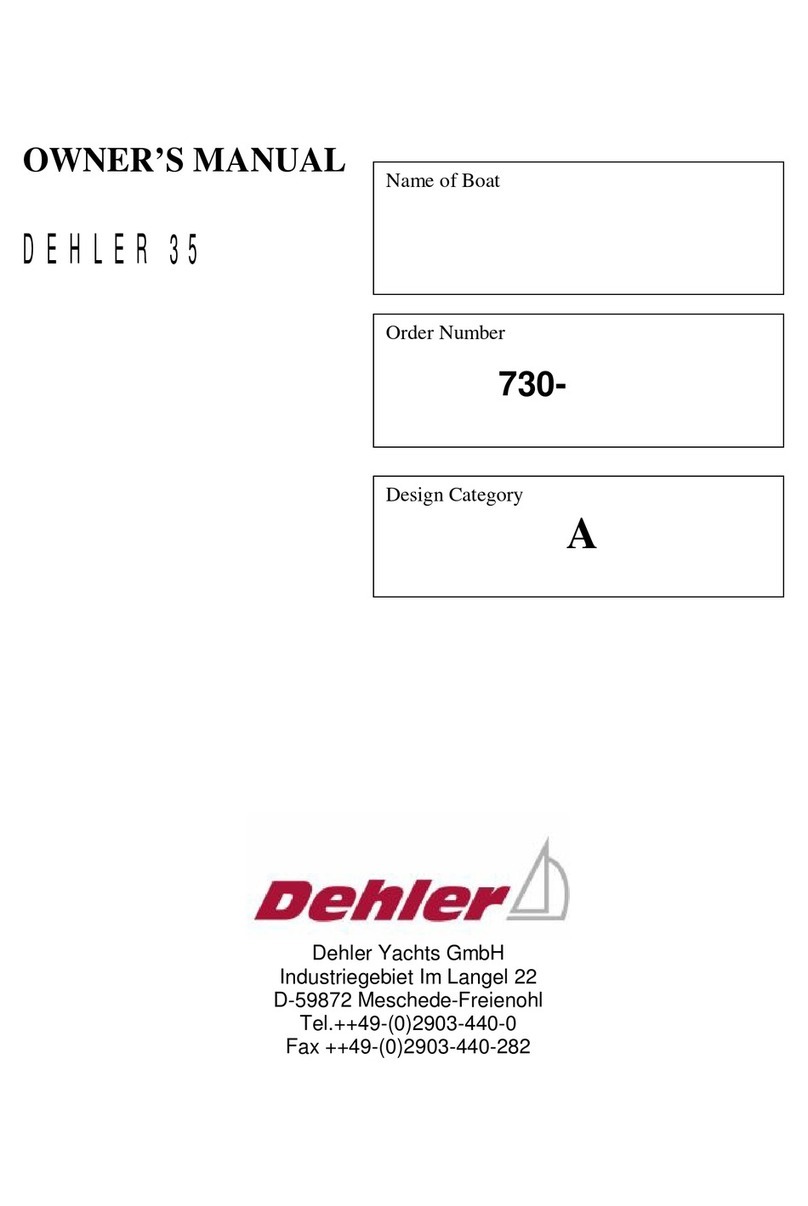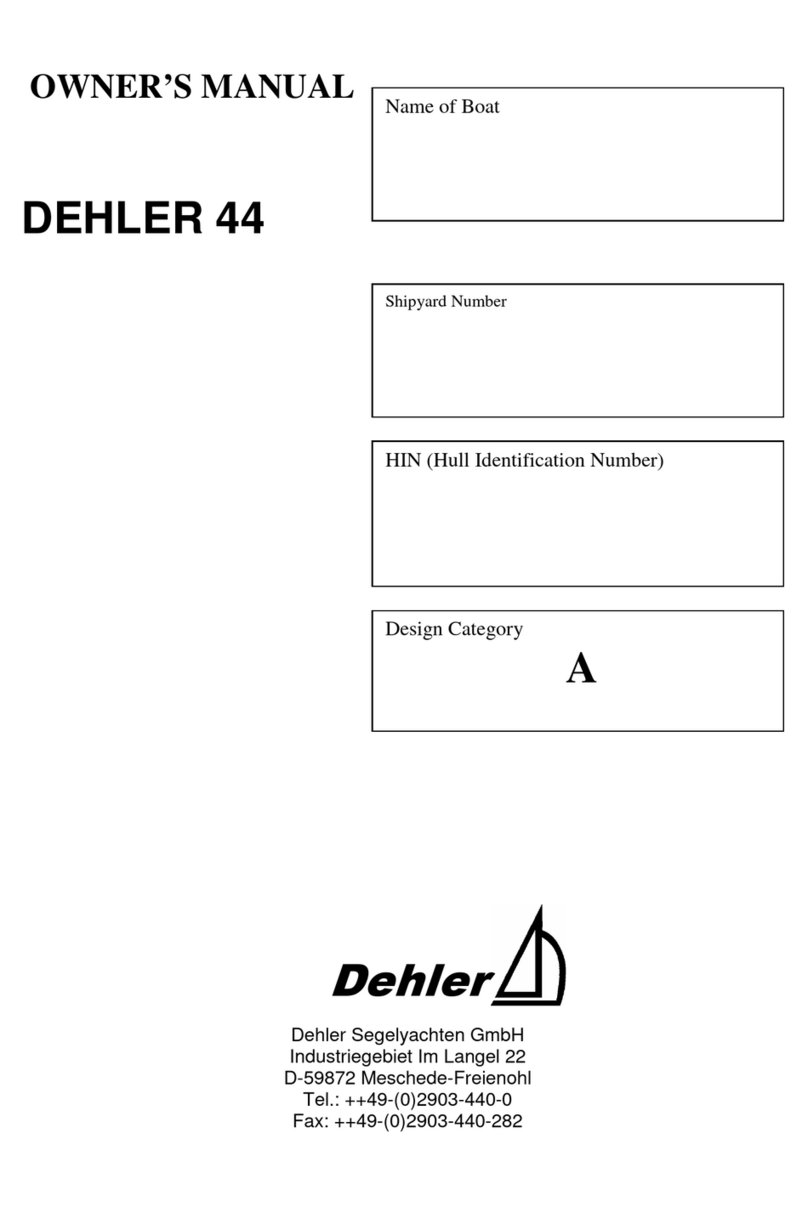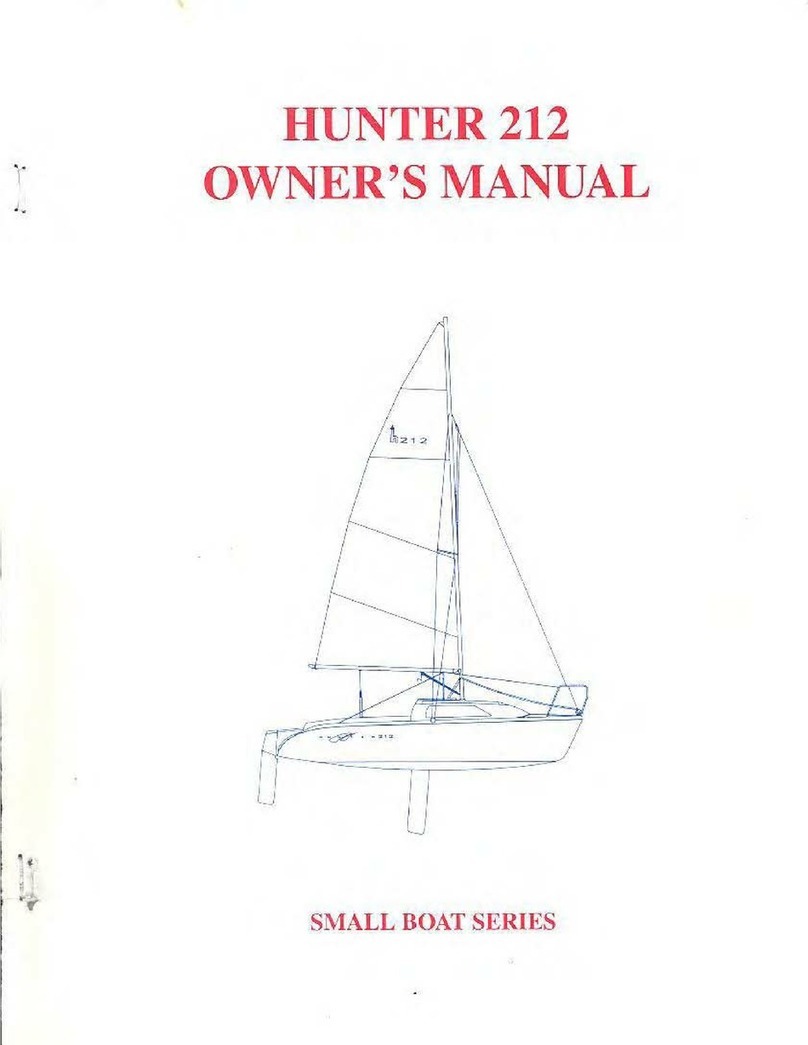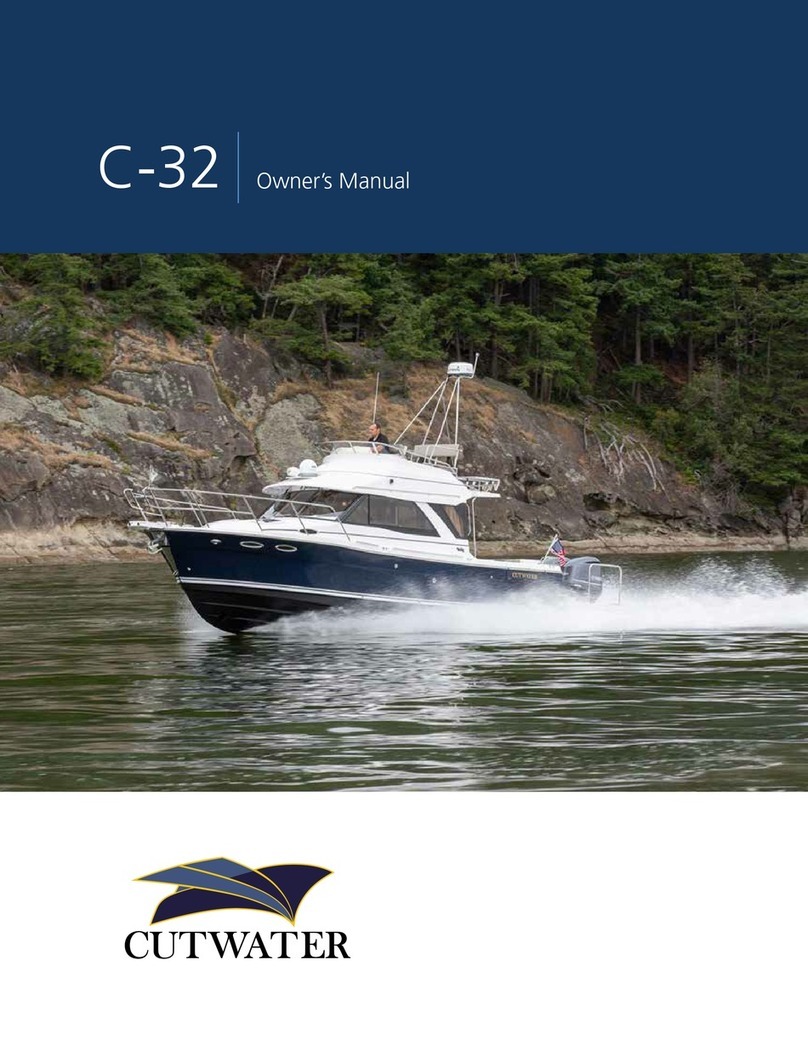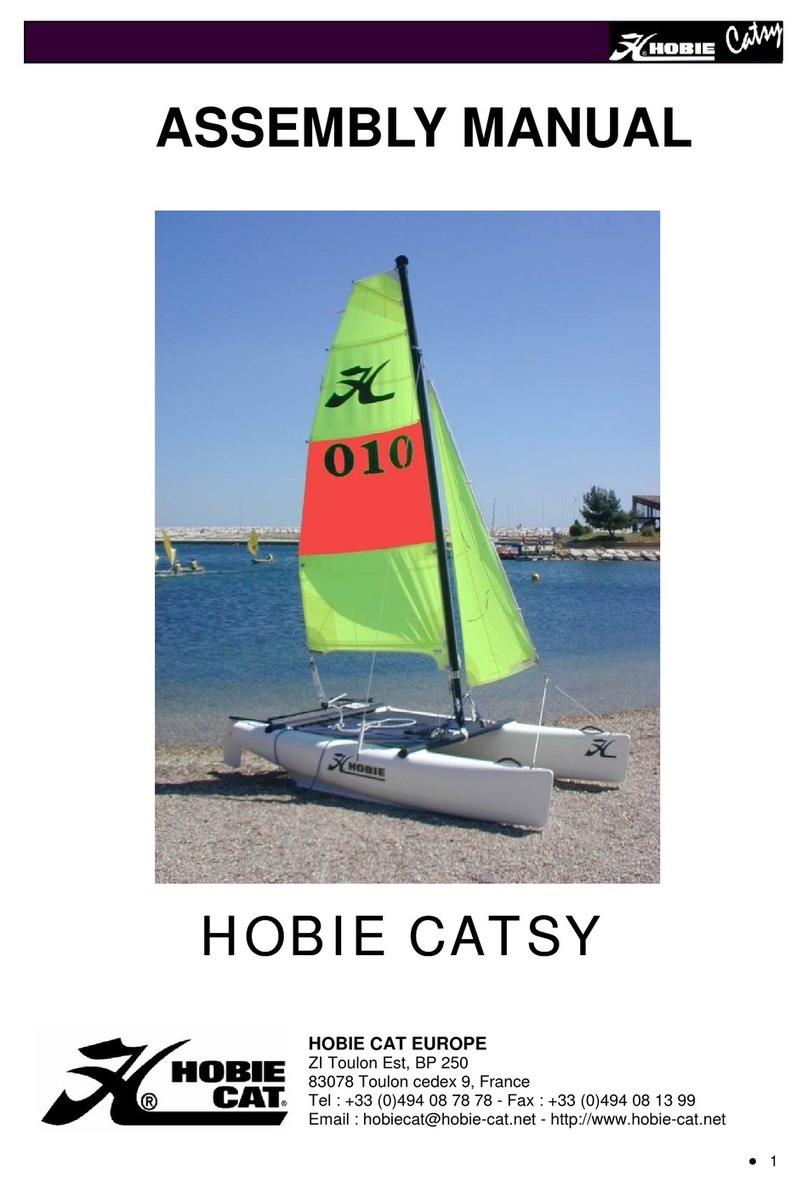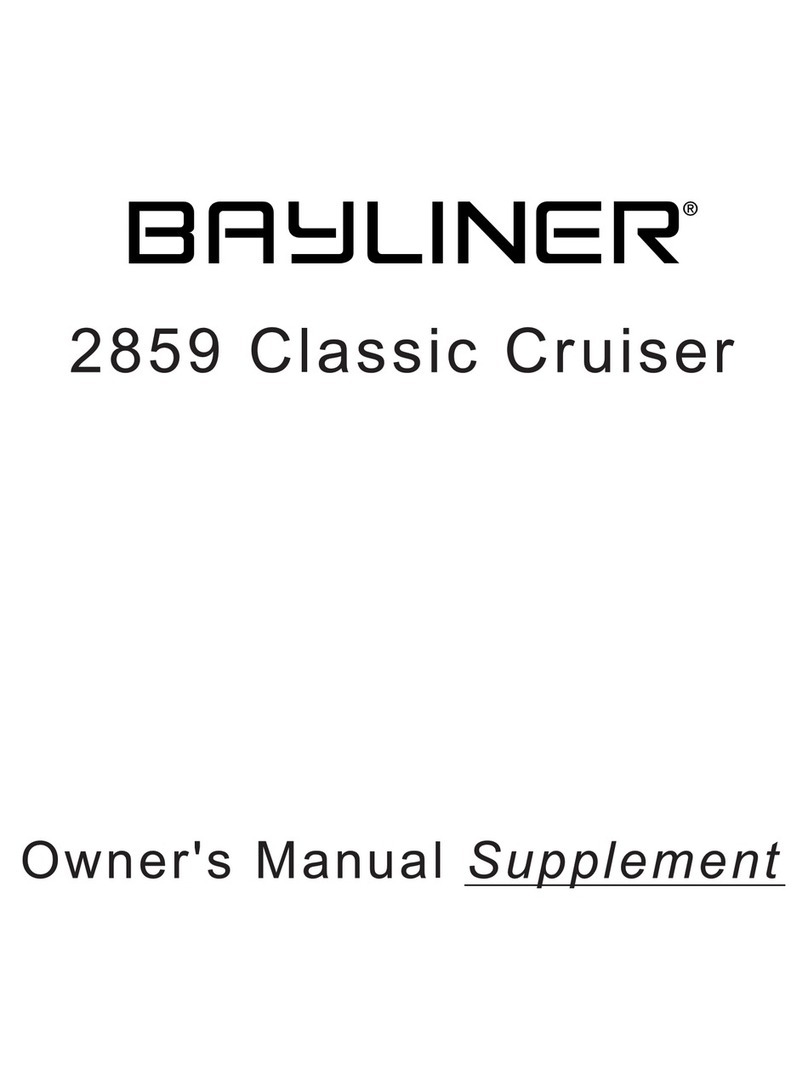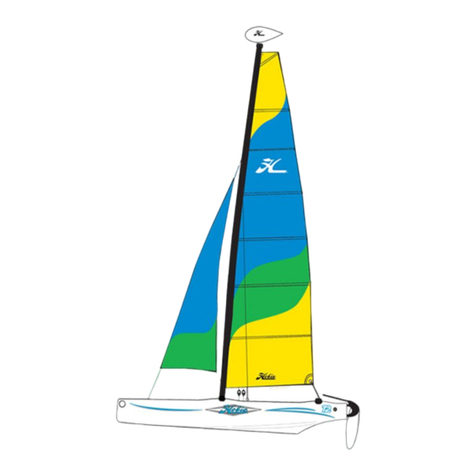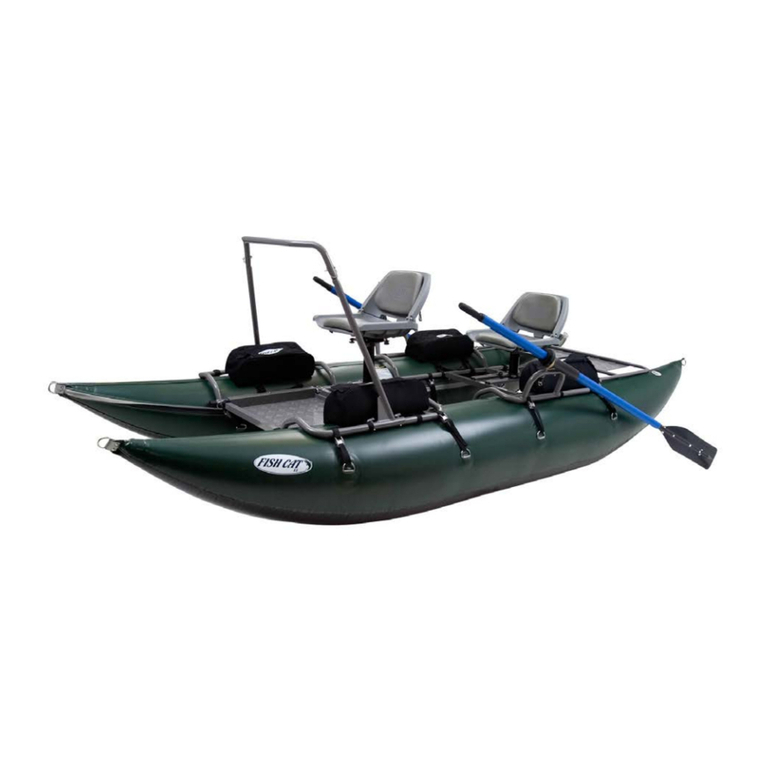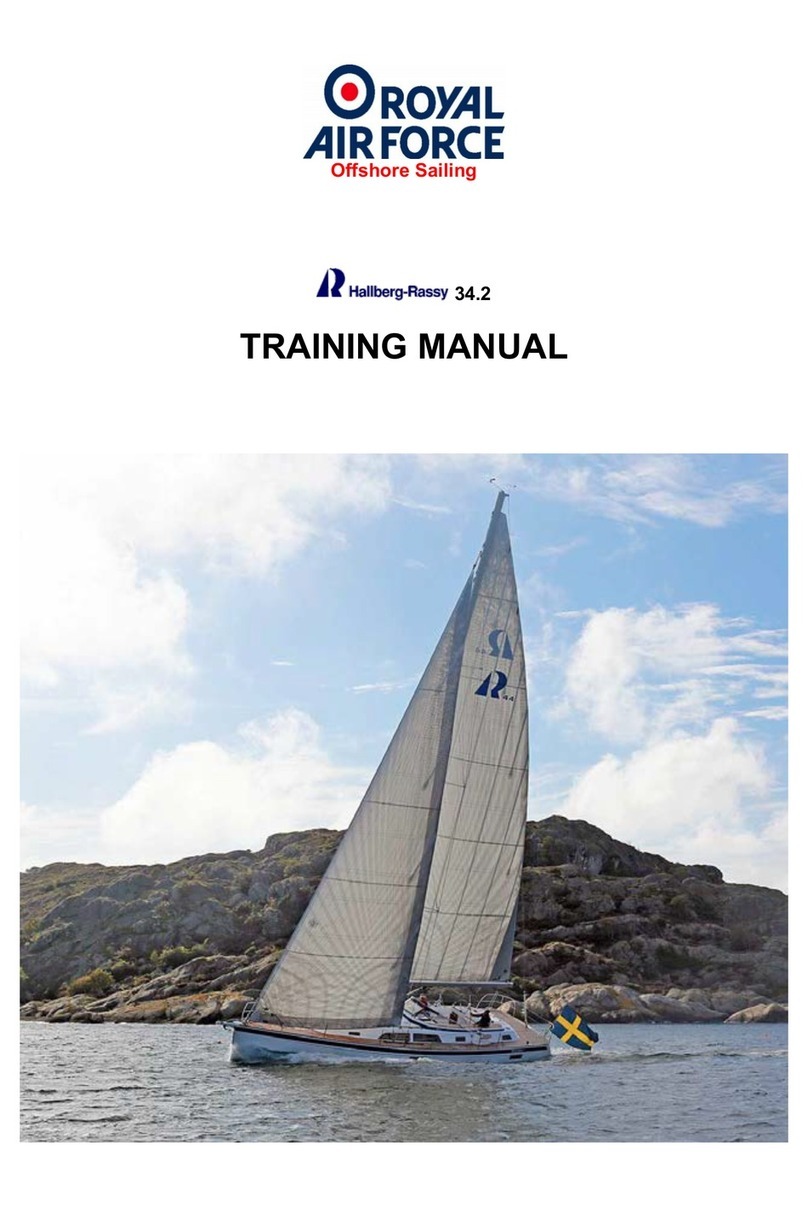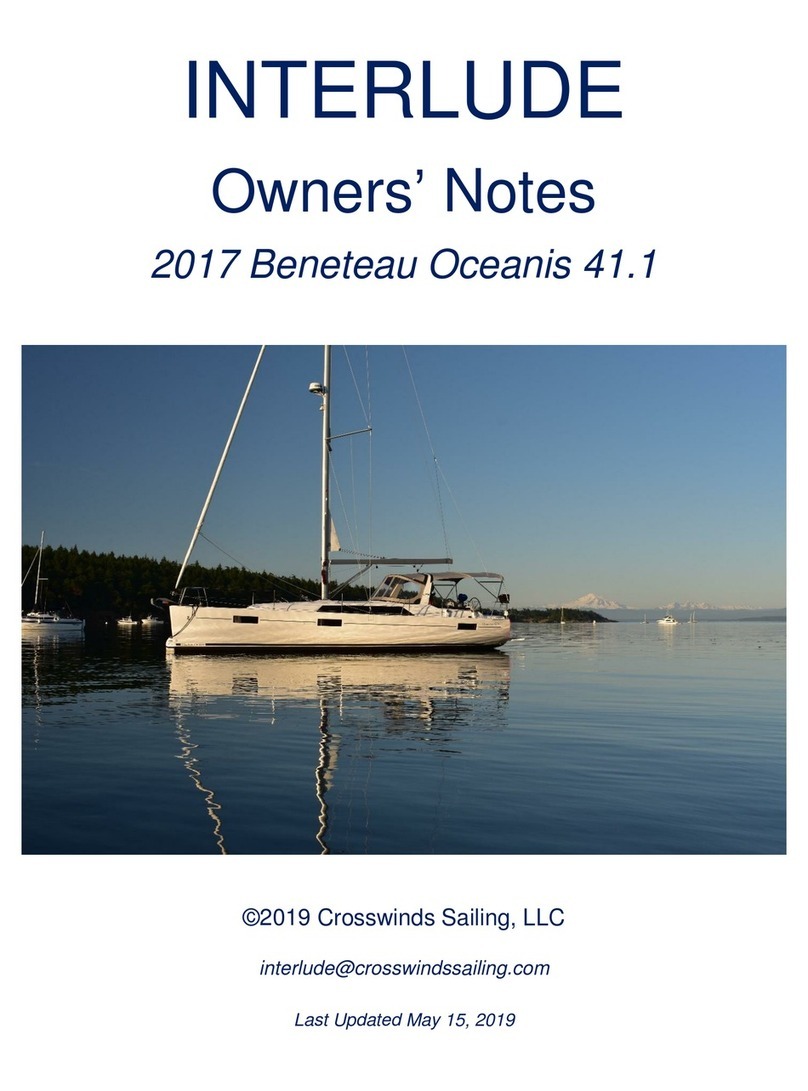Dehler 34 Instruction Manual

Owner’sSafety
Manual
Sailing Yacht “Dehler 34”
Dehler Yachts GmbH
Ladebower Chaussee 11
17493 Greifswald /Germany
Tel.: +49 (0) 3834 5792-0; Fax: +49 (0)3834 5792-81
www.dehler.com

Details:
Owner’s Safety Manual
Owners Manual D34 Buch eng V1 - allg.docx
June 2016

D E H L E R 3 4
Table of Contents
Introduction III
Design Category, Identification V
Builder’s Plate V
Warning Notes VI
Declaration of Conformity VII
CHAPTER 1 – SAFETY NOTES 1
1.
Description of the Boat 1
1.1.
G
ENERAL DESCRIPTION
1
1.2.
M
AIN DATA
1
1.2.1.
Main dimensions 1
1.2.2.
Displacement and masses 3
1.2.3.
Maximum number of persons and load capacity 4
1.2.4.
Motorization 5
1.2.5.
Electrical system 5
1.3.
G
ENERAL PLAN
7
1.3.1.
Description of the structure 7
1.3.2.
Sail plan - standard 11
1.3.3.
Sailplan - competition 16
1.3.4.
Bowsprit 23
1.3.5.
General arrangement 24
1.4.
P
ROPULSION SYSTEM
24
1.4.1.
Engine, Engine room, reduction gear 24
1.5.
S
AFETY NOTES
25
1.5.1.
Flooding, watertight integrity 25
1.5.2.
Hull openings, seacocks 26
1.5.3.
Stability 27
1.5.4.
Fire protection 27
CHAPTER 2 – FURTHER TECHNICAL DETAILS 32
1.
Installations and Systems 32
1.1.
T
ANK CAPACITIES
32
1.2.
W
ATER SYSTEMS
33
1.2.1.
Drinking water 33
1.2.2.
Seawater 35
1.2.3.
Grey water 35
1.2.4.
Black water 37
1.2.5.
Bilge system 39
1.3.
F
UEL SYSTEM
41
1.4.
S
TEERING SYSTEM
43
1.5.
E
LECTRICAL SYSTEMS
45
1.5.1.
Direct current system 49
1.5.2.
Alternating current system 51
1.5.3.
Navigation systems 52
1.6.
A
NCHORING
,
TOWING AND MOORING EQUIPMENT
53
1.6.1.
General 53
1.6.2.
Anchoring 53
1.6.3.
Towing 54
1.6.4.
Mooring 54
1.7.
E
NGINE SYSTEM
55
1.7.1.
Structure of the engine room 55
1.7.2.
General 56
1.7.3.
Instruments 56
1.7.4.
Cooling system 56
1.7.5.
Exhaust system 57
1.7.6.
Lubrication 58
1.7.7.
Gearing 58
1.7.8.
Gear shift 58

D E H L E R 3 4
1.7.9.
Sail drive 58
1.7.10.
Propeller 59
1.8.
V
ENTILATION
59
1.9.
H
EATING
60
1.10.
L
IQUEFIED PETROLEUM GAS SYSTEM
61
1.10.1.
Installation 61
1.10.2.
Replacement of the gas cylinder 62
1.10.3.
Operating the gas system 63
1.11.
C
ORROSION PROTECTION
,
PAINTING SYSTEM
64
1.12.
M
ANUALS AND OPERATING INSTRUCTIONS
64
2.
Starting up 65
2.1.1.
General notes 65
2.1.2.
Attachment points for lifting gear, support points for slipping and transport 65
2.2.
U
NDERWATER PAINTING
66
2.3.
E
NGINE
,
PROPELLER
66
2.4.
E
QUIPMENT
66
2.5.
F
IRST VOYAGE
66
2.6.
M
ANOEUVRING BY ENGINE
67
2.7.
C
HECKING THE SYSTEMS
67
3.
Environmental Protection 68
3.1.
F
UELS AND OIL
68
3.2.
W
ASTE
68
3.3.
S
OUND
68
3.4.
S
WELL
68
3.5.
E
XHAUST GASES
68
3.6.
A
NTIFOULING
,
PAINTING
69
3.7.
V
ARNISH REMOVER
69
3.8.
B
LACK WATER
69
3.9.
N
ATURE CONSERVATION
69
4.
Maintenance 70
4.1.
E
XTERNAL INSPECTION
71
4.2.
M
AINTENANCE AND CLEANING
71
4.3.
R
IGGING AND SAILS
72
4.3.1.
Rigging 72
4.3.2.
Sails 73
4.4.
P
AINTING
73
4.5.
W
EAR AND SPARE PARTS
73
4.6.
R
EPAIRS
73
4.7.
I
NSPECTION OF UNITS AND SYSTEMS
73
4.8.
W
INTER STORAGE
75
4.8.1.
Hull and deck 75
4.8.2.
Rigging 76
4.8.3.
Electrical equipment 76
4.8.4.
Systems and tanks 76
5.
Live saving appliances 76
6.
Warranty 77
7.
Concluding remarks and notes 77
8.
List of delivered manuals, plans and operating instructions 77
Proof of Identity
Acknowledgement of Receipt

D E H L E R 3 4
Introduction
This manual is to help you handle your sailing yacht safely and with pleasure. It contains general
information on the yacht and its systems, as well as on operation and maintenance. Please use this
manual to acquaint yourself with your yacht before setting off on your first voyage. Further help
regarding individual devices that are part of the yacht’s equipment can be obtained in the device’s
operating instructions.
This Skipper’s Manual is not a course dealing with watercraft safety or the art of sailing. For your own
safety and convenience, should this be your first sailing yacht or if you are not yet familiar with the
special features of a sailing yacht, please acquaint yourself with the handling and operation of this yacht
before taking charge of it. Your dealer or national sailing or motor boat association or yacht club will be
pleased to inform you of training possibilities in case you would like to expand or refresh you knowledge
in this way.
Please make sure that the expected wind and swell conditions are in accordance with the design
category of your boat and that you and your crew are capable of handling the boat under these
conditions.
Your yacht is adequately designed, but you must be able to cope with the sea and wind conditions of
storms of category A up to the serious conditions of the top category C, including the risk of breakers or
strong gusts of wind, which comply with the design categories A, B and C. They are considered to be
dangerous conditions under which only a competent, capable and trained crew with a well maintained
watercraft can operate in a satisfactory manner.
This manual is not a detailed instruction guide for maintenance or trouble-shooting. In case of problems,
please consult your dealer. If a maintenance manual is provided, use it to perform maintenance on your
watercraft.
Only commission trained and competent staff for maintenance, repairs or modifications of this yacht.
Modifications that could have an impact on the safety features of the boat must be assessed,
implemented and recorded by qualified specialists. The boat’s manufacturer cannot be made
responsible for modifications that he has not approved.
In some countries, a license or an authorisation is required, or special regulations apply.
Perform maintenance work on your boat in a proper manner and consider the wear that can occur over
time and through frequent or improper use of the boat.
Any watercraft, no matter how solidly it is built, can be seriously damaged by improper handling. This is
not compatible with safely handling of your boat. Always adapt the boat’s speed and direction of travel
to the sea conditions.
If your boat is equipped with an inflatable life raft, read the corresponding operating instructions
carefully. The watercraft should have the appropriate rescue equipment on board (life jackets, safety
belts, etc.) in accordance with the type of watercraft, the weather conditions, etc. In some countries, this
equipment is mandatory. The crew should be familiar with how to handle all safety equipment and with
manoeuvring in cases of emergency (man-overboard rescue, mooring, etc.). Sailing and motor boat
schools and clubs organise training courses on a regular basis.
When above deck, all persons should wear buoyancy aids (life jackets, personal buoyancy aids). Please
pay attention to the fact that in some countries legal requirements stipulate wearing a buoyancy aid in
compliance with national regulations.
We recommend keeping this manual on board so that it can be used as an operating guide or for
possible trouble-shooting.
Certain figures may contain equipment features that are not included in the contract.

D E H L E R 3 4
PLEASE KEEP THIS MANUAL IN A SAFE PLACE AND GIVE IT TO
THE NEW OWNER IF YOU SELL THE YACHT.
The Dehler Yachts GmbH warmly welcomes you to the circle of Dehler sailing yacht owners and
thanks you for the confidence you have placed in our product by purchasing this yacht.
Your contracting party as well as the management and employees of Dehler Yachts GmbH wish you a
lot of pleasure with your new sailing yacht.
May you always have good sailing!
Dehler Yachts GmbH
Management

D E H L E R 3 4
Design Category
According the European Recreational Craft Directive each craft has to meet the requirements of the
intended design category.
The sailing yacht “Dehler 34” is certified according design category B.
In the Directive, design category B is characterised as follows:
Design category B:
A recreational craft given design category B is considered to be designed for a wind force up to, and
including, 8 and significant wave height up to, and including, 4 m.
Certification
In accordance with the EC Directive, the certification module A1 was chosen for this yacht. The boat
was built while taking the internal production control into account. The manufacturer has confirmed the
conformance with the European Recreational Craft Directive.
The stability and watertight integrity have been tested by a notified body using the applicable standards.
The DNV-GL SE, located in Hamburg, was commissioned as a notified body according to the EC
Recreational Craft Directive (see Declaration of Conformity).
CIN - Identification
The hull identification is mounted on the starboard side of the transom. It is a globally unique sequence
of numbers and letters.
This CIN number is affixed a second time at a hidden place only known to the manufacturer in order to
identify your yacht in case of theft.
The CIN number is on the Declaration of Conformity and on the Builder’s Certificate.
Builder’s Plate
In accordance with the requirement of the Directive, the builder’s plate is affixed in the cockpit. The
information it contains is stipulated and should be explained here.

D E H L E R 3 4
Explanations
Warning Notes
In many chapters of the owner’s manual you will find notes meant to facilitate trouble-free operation and
maintenance, but also to warn against dangers. For reasons of clarity, they are highlighted in boxes.
Denotes that an extreme intrinsic hazard exists which would result
in high probability of death or irreparable injury if proper
precautions are not taken.
Denotes that a hazard exists which can result in injury or death if
proper precautions are not taken.
Denotes a reminder of safety practices or directs attention to
unsafe practices which could result in personal injury or damage to
the craft or components.
Here we give you valuable advice facilitating the operation or handling
of the craft or its components.
–
Design Category B :
– Max. 8 = 600 kg:
Maximum number of persons defined by the
manufacturer when the boat is underway in the sea
territory of its design category.
– Max. + = 950 kg:
The maximum additional load consisting of 8
persons, provisions stores and cargo (tank capacities
are not included). Please take note of section 1.2.2.
– CE: CE marking as proof that the boat was built
according to the requirements of the Directive

D E H L E R 3 4
Chapter 1 – Safety Notes
1. Description of the Boat
1.1. General description
You can find the general description of the yacht in the standard specification and the
corresponding contract specification.
1.2. Main data
1
1.2.1. Main dimensions
Maximum length
(bow sprit)
L
max
11.00 m
Maximum length L
max
10.70 m
Length of hull L
H
10.30 m
Length of waterline L
WL
9.50 m
Beam of hull B
H
3.60 m
Mast height – DWL (standard) 16.27 m
Mast height – DWL (competition) 17.02 m
Draught (lower edge of the keel) T
max
Deep keel approx. 2.10 m
Medium keel approx. 1.95 m
Shallow keel approx. 1.55 m
Sail surface (standard)
2
Mainsail 37.50 m²
Genoa 105% 27.50 m²
Sail surface (competiton)
2
Mainsail 41.00 m²
Genoa 105% 30.00 m²
The specified sail surface may not be expanded without prior
consultation with the shipyard.
1All dimensions, weights and surfaces are approximate values.

D E H L E R 3 4
A = maximum length
(bow sprit)
: 11.00 m
A = maximum length: 10.70 m
B = hull length: 10.30 m
C = height hull – instrument console: 2.40 m
D = height hull – pulpit: 2.45 m
E = beam of hull: 3.60 m
keel dimension:
shallow keel standard L-keel deep keel
F 1.53 m 1.62 m 1.58 m
G 1.94 m 1.70 m
H 2.11 m 2.18 m 2.22 m
I 1.04 m 1.48 m 1.65 m
J 0.42 m 0.38 m 0.41 m
shallow keel
deep keel
standard L
-
keel

D E H L E R 3 4
Fuel tank content 156 l
Water tank content 210 l
1.2.2. Displacement and masses
Design Category B :
Aluminium rig
Carbon rig
*) Included in the load capacity on the builder’s plate
The owner or skipper is responsible for ensuring that the fully
equipped boat does not exceed the mass according to the table
above.
Shallow
keel
Medium
keel
Deep
keel
Mass of the empty craft vessel m
EC
5.997 kg 5.865 kg 5.545 kg
Basic equipment 159 kg 159 kg 159 kg
Mass of the light craft condition m
LC
6.156 kg 6.024 kg 5.704 kg
Optional equipment 806 kg 806 kg 806 kg
Mass of liquids in installed tanks
(95%)
347 kg 347 kg 347 kg
Equipment 80 kg 80 kg 80 kg
Stores, cargo and provisions
*)
350 kg 350 kg 350 kg
Number of persons (persons)
*)
600 kg 600 kg 600 kg
Mass of the fully loaded boat
– ready to sail
m
LDC
8.339 kg 8.207 kg 7.887 kg
Shallow
keel
Medium
keel
Deep
keel
Mass of the empty craft vessel m
EC
5.944 kg 5.812 kg 5.492 kg
Basic equipment 159 kg 159 kg 159 kg
Mass of the light craft condition m
LC
6.103 kg 5.971 kg 5.651 kg
Optional equipment 806 kg 806 kg 806 kg
Mass of liquids in installed tanks
(95%)
347 kg 347 kg 347 kg
Equipment 80 kg 80 kg 80 kg
Stores, cargo and provisions
*)
350 kg 350 kg 350 kg
Number of persons (persons)
*)
600 kg 600 kg 600 kg
Mass of the fully loaded boat
– ready to sail
m
LDC
8.286 kg 8.154 kg 7.834 kg

D E H L E R 3 4
1.2.3. Maximum number of persons and load capacity
The directive requires that for each craft a maximum number of persons is defined who should
be on board when the boat is in the service area it was conceived for. This yacht is designed for
the ocean navigation, i.e. for extended voyages between ports.
Therefore the recommendation is the following:
Voyages of several days duration the maximum number of persons should greater than the
number of berths onboard.
This design category considers a maximum wave height including 4 m and a wind speed
including 8 Beaufort, under the precondition that:
•the crew has sufficient nautical knowledge and experience;
•the construction of the boat is suitable for the intended weather conditions and its equipment
is well maintained.
Life jackets must be provided for all persons on board. The inflatable
life raft should have a capacity of 8 persons.
Put on personal safety equipment (life jacket etc.) during the trip!
The defined maximum number of persons may not be exceeded. No
matter how many persons are on board, the total weight of persons
and equipment may never exceed the recommended maximum load
capacity.
The stability characteristics of the craft were designed for the
specified weights and the intended arrangement and storage of the
additional load.
The following notes should be paid attention:
•the crew members should be trained sufficiently;
•the boat should not be loaded beyond the limit recommended by the manufacturer;
•water in the bilge should be drained to the greatest extent possible;
•stability is reduced by heavy loads above the centre of gravity;
•in case of rough weather, the hatches, locker seats and companionways must be kept
shut to keep the risk of water penetration as low as possible;
•stability is reduced, if davits are used for towing or for lifting heavy weights;
•breaking waves are dangerous and may influence the stability of the yacht.
Weather conditions under which breaking waves could approach the
boat abeam are to be avoided. Voyages should be planned in
consideration of weather forecasts.

D E H L E R 3 4
Additional load
The Directive requires the specification of the maximum additional load by the manufacturer. It
contains persons and the equipment marked with
*)
in 1.2.2. The maximum load capacity is
indicated on the builder’s plate. The maximum additional load for the “Dehler 34” is 950 kg for
design category B.
The specified maximum additional load must never be exceeded
when loading the craft. Loading must always be carried out
cautiously, distributing the load in such a way that the design trim is
maintained. Heavy load must be placed as low as possible.
Liquids are not considered in the maximum additional load.
When the space underneath the floor or the beds is used as store
room, it has to be ensured that here installed devices and appliances
will not be damaged.
1.2.4. Motorization
For engine details and its technical specifications, please refer to the operating instructions for
the engine and the contract specification.
Max. power (EN ISO 8665) max. 21,0 kW (28 HP)
Number 1
Cooling indirect (seawater/fresh water)
1.2.5. Electrical system
The yacht is equipped with an electrical system with 12 V direct current and a 230 V alternating
current system.
Do not modify the craft’s electrical systems or relevant drawings. Installation, alterations and
maintenance should be performed by a competent marine electrical technician. Inspect the
system at least biennially.
Open the switchboards only when they are current free, because
you might contact live elements that are not protected by fuses.
There is a risk of electric shock.
There is a risk of fire and explosion when handling electrical direct
current (DC) and alternating current (AC) systems in an improper
manner.
2 3 0 V A L T E R N A T I N G C U R R E N T
Never perform work on a live alternating current system.
Heed the following notes:
•If possible, only use electrical consumers with earthed conductors.
•Connect metal housings or systems of installed electrical devices to the earthed conductor in
the boat (green or green with yellow stripes).

D E H L E R 3 4
Never leave the shore-connecting cable hanging in the water. This
could injure or result in the death of persons swimming nearby!
To avoid electric shocks and to reduce the risk of fire
•Do not modify the electrical system. Allow work to be done on
the electrical system only by qualified specialists for marine
electrical equipment!
•If possible, only use devices that are insulated twice or triple
braided!
•Switch the shore connection switch off first before plugging or
unplugging the shore connecting cable.
•Connect the shore-connecting cable to the boat first before
connecting it to the shore source of power.
•First separate the connection at the shore source of power.
•If the reverse polarity display
1
is activated, disconnect
immediately!
•Close the cap of the shore connector box.
•
Do not modify the shore connections, only use compatible
circuit connectors.
12 V direct current
Batteries supply the current for the 12V installation on board.
Distribution occurs via the distribution fuse panel. The labels next to the switches designate the
respective consumers. If required, your dealer can provide the circuit diagram.
Changing the batteries
When removing the batteries, always disconnect the negative pole first and make sure that the
pole terminal does not come in contact with other parts of the electrical system! Take care not to
simultaneously touch both poles with the tool you are using, thus establishing an electric circuit.
Only use insulated tools to detach or fasten the pole terminals at
the batteries.
There is a risk of fire and injuries!
When connecting the batteries, take care to first plug in and secure the positive poles before
subsequently attaching the negative poles.
Only use AGM- or gel batteries with same or higher capacity!
1Depending on the contract specification

D E H L E R 3 4
1.3. General plan
1.3.1. Description of the structure
Structure
The sailing yacht “Dehler 34” is a cruiser constructed using a combination of vinylesther
sandwich (hull) and FRP sandwich (deck).
1
The properties of all utilised materials comply with the requirements of classification societies or
ISO standards.
Should you require these materials or the accompanying data sheets, please contact your dealer.
Always maintain a sufficient distance to the sea bed. On principle, it is not possible to take severe
collisions with solid underwater obstacles into account when dimensioning the yacht.
Touching the sea bed or collisions with objects below the
waterline can result in damage to the hull and thus impair its
strength.
Preservation
Osmosis protection is ensured by the use of an isophthalic acid gel coat and an vinylesther resin
for the hull outer skin. In addition, areas of the laminate surfaces heavily exposed to water were
preserved with a top coat.
All parts not consisting of FRP are necessarily colour-preserved or consist of materials which are
corrosion resistant.
The underwater part was preserved with a special antifouling painting system to prevent marine
fouling.
Deck covering
All areas of the working deck are covered with anti-slip surfaces.
Fittings and hatches
All hinges and hatches are made of stainless- and sea-water resistant material. They are carefully
screwed on deck in order to be watertight. At the mounting points of the fittings reinforcements
are laminated into the deck so that existing forces can be transferred into these points.
The hatches and portlights as well as the windows are certified or in compliance with the
requirements or regulations such that they resist the impact of breaking waves.

D E H L E R 3 4
Fig.
1
General plan

D E H L E R 3 4
Working deck
The working deck consists of all areas that must be accessed to operate the boat under normal
conditions. The bathing platform and the transom do not belong to the working deck (Fig 3).
Never enter the areas that do not belong to the working deck
when the boat is underway. There is a risk of falling overboard.
Only step or stand on the seats in the cockpit to move about on deck! Don't step on the sliding
hatch at the companionway or its cover!
It is generally recommended to secure persons on deck with personal rescue and safety
equipment (e.g. life jackets, safety belts).
Please make sure that you do not enter between the bulwark and
the quay wall or other boats.
There is no foot stop at the rear part of the cockpit. Please take note of this when you are there.
Do not leave loose objects lying in the area of the working deck or
the emergency hatches. Secure all pieces of equipment against
sliding!
Guardrail
The boat has a surrounding guardrail with a hand and intermediate rail. Except for the bow and
stern pulpits, the hand and intermediate rails are made of stainless steel.
Handrails and boarding ladder
Additional handrails and the arrangement of the deck fittings provide protection against falling
overboard.
The boarding ladder is on the pushpit. It extends below the waterline. Re-boarding is ensured by
the boarding ladder. Familiarize yourself with the handling of the boarding ladder and practice re-
boarding, e.g. in a man overboard manoeuvre (MOB).
An additional ladder for the bathing platform is on board. This should be always in the same
place (cockpit locker) and always ready to use!
In an emergency to rescue open the bathing platform, put the ladder in the fittings and fold it
down in the water.
Instruct the crew before you start the voyage! We advise you
against sailing the yacht alone (single-handed yachtsman).
working deck

D E H L E R 3 4
The means of reboarding shall be permanently deployed if the craft is used singlehanded,
whether anchored, moored, stationary or under way.
One should furthermore take precautions to comply with the "rules of good seamanship" (lifebelt,
life lines, connecting belt as short as possible ...).
To install the reboarding ladder:
1. Cow hitch the reboarding
ladder around the pushpit.
The loop of ladder needs to
face outboard.
2. Pass the flap of the case
between the loop of the
cow hitch and the top step.
3. Screw the flap to the case
with the two screws and
nuts.
The nuts should be facing
the outside of the case.
4. Test the ladder to be sure it
falls correctly in the water.
It is important to ensure
that the ladder deploys
safely into the water.
Finally, fold the ladder back
into its case and close the
flap with snaps.
Your rescue ladder is
ready.
The cord should be cut flush with the waterline to
avoid the risk that it will get caught in the
propeller.
It must remain in position, accessible from the
water when the boat is sailing.

D E H L E R 3 4
1.3.2. Sail plan - standard
Mainsail 37.5 m²
Genoa (105%) 27.5 m²
Gennaker 90.0 m²
P = 13.25 m
E = 4.95 m
I = 13.60 m
ISP = 14.80 m
J = 3.87 m
TPS = 4.10 m
LP (105%) = 4.06 m

D E H L E R 3 4
Rigging plan and halyard running
The specification for standard Selden rig.
Other manuals for 34
1
Table of contents
Other Dehler Boat manuals
